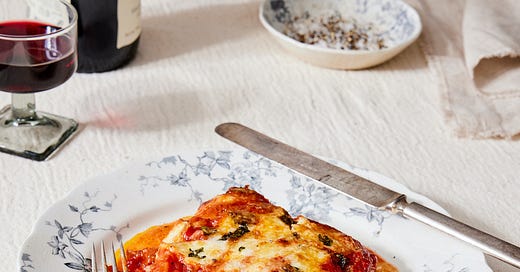

Discover more from The Jewish Table
Hey there, If you’ve found your way here but are not yet subscribed for the weekly newsletter, you can do that here. You will never miss a story or recipe, and I’ll be eternally grateful for your support.
Portico didn’t win a James Beard Media Award this year.
None of my other cookbooks have won James Beard Awards—widely considered the Oscars of food media—either. But this time felt different.
It is, of course, never wise to get one’s hopes up. But the moment I pressed “send” on Portico’s manuscript—shipping it off to my wonderful editor and effectively setting it in motion for publication—a little voice somewhere in me whispered, “This is the one. You did it.”
That was January, 2022. While the book was getting edited and designed, sent to the printer overseas and shipped back by boat, released to the public, and then submitted for awards consideration, that little voice stayed with me. So we’re talking literal years of wondering, anticipation, and hope.
Along the way, I experienced unimaginably wonderful moments on book tour. I delighted watching Portico connect with so many readers and cooks. I was thrilled when people told me how delighted they were by the Pizza Ebraica, how empowering it felt to learn how to properly trim an artichoke, or how much they discovered about Roman Jewish history reading the book’s introduction.
I also celebrated every accolade that came the book’s way, like being named a “best of 2023” book by a bevy of publications, and being a finalist in both the National Jewish Book Awards and—most impressively according to my son Max who is an insatiable reader—the Libby Book Awards.
But I admit, I was holding out for the “BIG” one.
The list of this year’s James Beard finalists dropped when I was in the car with my family. Did I cry when I scanned the titles and saw that Portico hadn’t made the cut? Yep, you bet I did. I generally think it is a good thing for parents to share real emotions and vulnerability in front of their children. But in that moment I felt at once deeply disappointed, a little foolish for allowing myself to be so confident, and ashamed that the kids saw me crying over something as relatively trivial as a cookbook award. It definitely wasn’t my favorite moment.
(Side note: despite my own own disappointment, I am genuinely happy for the excellent authors whose cookbooks did receive James Beard Award nominations (and even wins!) this year, including several friends and colleagues.)
On Loving the Work More
One of my all time favorite childhood books, Fables, which was written and illustrated by the incomparable Arnold Lobel, includes a story called “The Camel Dances.” It tells the tale of a camel who dreams of becoming a ballet dancer. After months of practice, she is told by critics watching her performance that she is “lumpy and humpy,” “baggy and bumpy” and “simply a camel.”
“How wrong they are!” the camel says to herself as her audience laughs and walks away across the desert sand. “I have worked hard. There can be no doubt that I am a splendid dancer. I will dance just for myself.”
I read Lobel’s story countless times as a child and have returned to it more than once as an adult. I always admired the camel’s unwavering confidence and determination to continue her passion—even when her efforts were mocked—simply because it was pleasurable to her.
Here’s the thing: Portico is not lumpy or humpy, baggy or bumpy. It is beautiful—the most fastidiously researched and deeply personal cookbook I have ever written. And it focuses on a cuisine that is fascinating, tantalizing, and deserves to be widely known and celebrated.
I have, of course, pondered why Portico was overlooked by the James Beard Award judges this year. In less charitable moments, I have let my mind drift to answers that I will refrain from sharing publicly. But in my gut I know that my “loss” has nothing to do with the book’s objective merits. Even so, Lobel’s ballerina camel feels deeply relevant.
No matter what our field of work is, it is vital to ask ourselves: if the external indicators of success—a promotion, a glowing performance review, an award—don’t come our way, do we still inherently love the work enough to keep doing it? Yes it stings to not be recognized, but if the work itself brings us meaning and, even better, creates meaning for others, I believe we can and should count ourselves among the fortunate.
I hesitated to write this newsletter for a couple of weeks because I was not (and am still not) sure how it will land. I worry that I will come across as vain or entitled. And I struggle with making myself publicly vulnerable. But I decided to go for it because I think and hope it might resonate with you.
I also wrote it because YOU, wonderful readers, are an enormous part of why I ultimately do love my work more than any award. I am grateful to say that I get enormous joy from publishing cookbooks and from writing this newsletter that has nothing to do with accolades and everything to do with community.
Do I still hope that a future cookbook of mine will someday win a James Beard nod? Of course. But in the meantime, I am content to do this work for me, for you, and for the love of Jewish cuisine.
Eggplant Parmesan (Parmigiana di Melanzane)
The eggplant parm in Portico has become a reader favorite—one of those recipes that people I don’t know message me about to tell me how much the enjoyed it. I totally understand why: my recipe is inspired by the incredible eggplant parmesan at Casalino Osteria Kosher in Rome’s Jewish Ghetto.
As I wrote in Portico: “[Casalino’s] version combined a tangle of silky, olive oil-infused eggplant with an abundance of garlicky tomato sauce and melted cheese. I am more familiar with American-style eggplant parmesan, which coats the eggplant pieces in breadcrumbs before frying them, but Casalino’s iteration of the dish was undoubtedly the best I have ever had.” With eggplant season on the immediate horizon, now is the perfect time to make it.
Serves 4 to 6
3 medium eggplants (about 3 pounds / 1.4 kg), not peeled, stems removed and sliced lengthwise into ¼-inch thick planks
Kosher salt
2 tablespoons extra-virgin olive oil
1 large yellow onion, finely chopped
4 medium garlic cloves, finely chopped
1/2 teaspoon freshly ground black pepper
One 24.5-ounce (700 g) bottle or can tomato puree (passata)
½ cup (120 ml) water
Vegetable oil (such as sunflower or grapeseed), for frying
½ cup (10 g) fresh basil leaves, roughly torn
1 pound (454 g) mozzarella, cut into ¼-inch cubes
2 cups (140 g) freshly grated Parmesan
Line two large baking sheets with clean dish towels or several layers of paper towels. Layer the eggplant planks on top (it’s okay if they overlap a little) and sprinkle generously with salt. Allow to rest at least 1 hour to draw out some moisture, then firmly pat them dry with paper towels.
Meanwhile, heat the olive oil in a large saucepan set over medium heat. Add the onion and cook, stirring occasionally, until softened and lightly browned, 6 to 8 minutes. Add the garlic, 1 teaspoon kosher salt, and the black pepper and cook, stirring, until fragrant, about 1 minute.
Stir in the tomato puree and water, partially cover the pan, and cook, stirring occasionally, until the sauce thickens, 15 to 20 minutes. Set aside.
Line a large plate or baking sheet with paper towels and set nearby. Heat ¼ inch of vegetable oil in a large frying pan over medium heat until shimmering. Add a single layer of eggplant planks to the hot oil and fry, flipping once, until lightly golden and tender, about 3 minutes per side. Transfer the fried eggplant to the prepared plate and continue frying the remaining eggplant in batches, adding more oil to the pan as necessary.
Preheat the oven to 400˚F (200˚C). Spread about one third of the tomato sauce into the bottom of a 9x13-inch baking dish. Layer about half of the eggplant slices over top, then top with one third of the sauce, and about half of the basil leaves, mozzarella, and Parmesan. Layer the remaining eggplant slices over top, followed by the remaining sauce, basil leaves, and both cheeses.
Bake, uncovered, until the eggplant mixture is bubbling and lightly browned, 30 to 35 minutes. Remove from the oven and let rest for 10 to 15 minutes before serving. It should be quite saucy and scoopable, rather than sliceable.
This recipe is reprinted, with permission, from Portico: Cooking and Feasting in Rome’s Jewish Kitchen, by Leah Koenig (W.W. Norton, 2023).
Subscribe to The Jewish Table
recipes + stories from the world of jewish food, by leah koenig






Dearest Leah
Your work is beautiful and impeccably tended to. Just like all you do. Your principles and how you approach life are admirable. I love you for all that you are.
Mom
PS. I cried when you didn’t win too.
Cause I’m your mom.
Well, fwiw, I’ve been telling every friend I have to buy Portico, given it as gifts and whenever I bring the chocolate almond cake to a Shabbat meal, it’s gone in minutes, and I love telling people where it came from. It’s one of the most beautiful cookbooks I own (and I have all of your others except Little Book of Appetizers, which I NEED.) I love the dancing camel thought process, so applicable to so many things we live through. I think there’s also a corollary to sending our children out into the world - we want everyone to see how wonderful they are and most often the world does, and when it doesn’t, we ache for them. Just keep dancing, Leah, and we will be dancing with you, spoons in hand, splattering the beautiful pages of Portico and waiting not so patiently for the next cookbook. ❤️